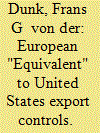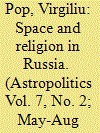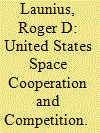|
|
|
Sort Order |
|
|
|
Items / Page
|
|
|
|
|
|
|
| Srl | Item |
| 1 |
ID:
089998


|
|
|
|
|
| Publication |
2009.
|
| Summary/Abstract |
This article analyzes the system developed within Europe, more precisely within the European Union through European Community law, to address the security-sensitive issues involved in the export of hardware, software, and knowledge for the purpose of space activities and major space applications. The subject is introduced with reference to the far better known export control developments within the United States, such as those concerning International Traffic in Arms Regulations, and the international understandings under the Missile Technology Control Regime and Wassenaar Arrangement. European Community Regulations for export controls provide for a complex system of balances between national sovereignty and Europe-wide harmonization. This European Community regime, though ultimately still dependent upon individual state's sovereign controls, establishes an interesting measure of international harmonization in security-sensitive export controls. Although the European Community regime is fraught with many complexities, it manages to avoid some of the pitfalls evident in the United States and international regimes, notably the confusing discussions on discerning weaponry proper from other space items with dual-use potential. This is the result mainly of an approach characterized by a primary intention to harmonize, rather than to apply strict controls per se, resulting in a transparency and consistency that are not only valuable to commercial entrepreneurs, but also to those concerned primarily with the security risks posed by the international space industry. As for the space industry in particular, it is helpful that the European Community regime specifically carves out civil space activities, for example if conducted within the context of the European Space Agency or national space agency activities.
|
|
|
|
|
|
|
|
|
|
|
|
|
|
|
|
| 2 |
ID:
090001


|
|
|
|
|
| Publication |
2009.
|
| Summary/Abstract |
This article follows the evolution of the relationship between the Russian space program and spirituality from an astrosociological perspective. It demonstrates that the Russian space program has its roots in Nikolai Fedorov's Cosmism, which envisaged the technological resurrection of the dead and space colonization, and in Marxism, which used space exploration as a means of proving atheism. Whereas the conquest of space has been perceived throughout the world in an ambivalent way, either as an act endorsed by Divinity or as a blasphemous feat, the Soviets took pride in reinventing the "Tower of Babel" in order to "make a name for themselves" and dethrone God (Genesis 11:4). Moreover, the technological miracles of spaceflight and the worship of Yuri Gagarin support the view that Soviet Communism was a state religion. After the fall of the Soviet Union, Orthodox Christianity brought its own contribution to the Russian space program. It will be also shown that, even during the Soviet period, appearances contrasted with the feelings of many of the cosmonauts.
|
|
|
|
|
|
|
|
|
|
|
|
|
|
|
|
| 3 |
ID:
089999


|
|
|
|
|
| Publication |
2009.
|
| Summary/Abstract |
The development of micro-satellites, including nano-satellites, has opened up opportunities for their varied uses. One such utility is as space mines. The purpose of this instrumentality is protective and defensive to escort important space-mission vehicles. These act as security commandoes till impelled to action by anticipated threat or hostile intruder entering the path. Similarly, conventional land mines can be adapted for use on the surface of the moon. These, also termed "space mines," can serve as proximity or peripheral defense to installations and national assets on the moon and other celestial bodies.
Space mines by their small mass and weight or nature of operation cannot be regarded a weapon of mass destruction or used as nuclear weapon prohibited under the Outer Space Treaty. Secondly, their deployment in passive defensive role does not foul with any substantive provision of space law. Nor are these prohibited by any definitional embargo. Illusioned by the apparent legality, space mines could be strategized in large configurations making outer space environment denser for safe space traffic. Modern satellites are high-cost vehicles and their operational economics cannot brook attrition.
Considering the comparable purpose and role of space mines, one needs to draw wisdom from experience with landmines or cluster bombs. These have been banned on the earth after suffering enormous losses and tragedy. Prudence ordains to learn from past mistakes and it would seem sagacious to nip the evil of space mines in the bud itself.
|
|
|
|
|
|
|
|
|
|
|
|
|
|
|
|
| 4 |
ID:
089996


|
|
|
|
|
| Publication |
2009.
|
| Summary/Abstract |
From the very beginning of the space age, the ability to undertake non-military activities in this new regime has been an element of foreign policy. The mirror image twins international cooperation and competition between nation states has driven many of the key decisions in the major programs undertaken by the United States, especially in the evolution of its human spaceflight initiatives. For much of the Cold War era, head-to-head competition with the Soviet Union defined the human program, especially the Apollo program to land astronauts on the Moon. In the aftermath of the Cold War foreign policy objectives still inform the delineation of policy, especially the cooperative nature of large programs such as the International Space Station. This essay explores the evolution of the place assigned international space cooperation and competition in the United States.
|
|
|
|
|
|
|
|
|
|
|
|
|
|
|
|
|
|
|
|
|